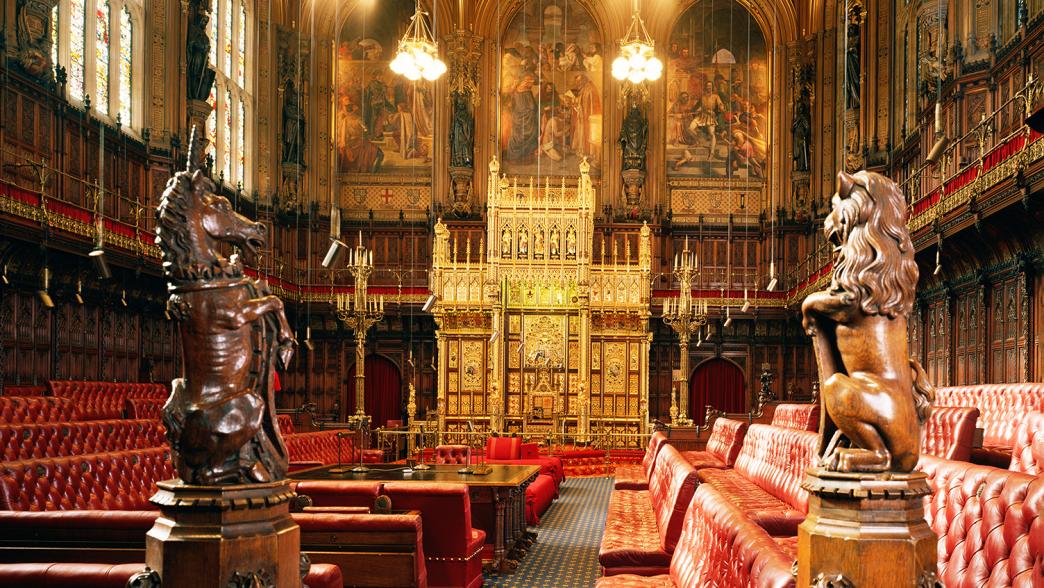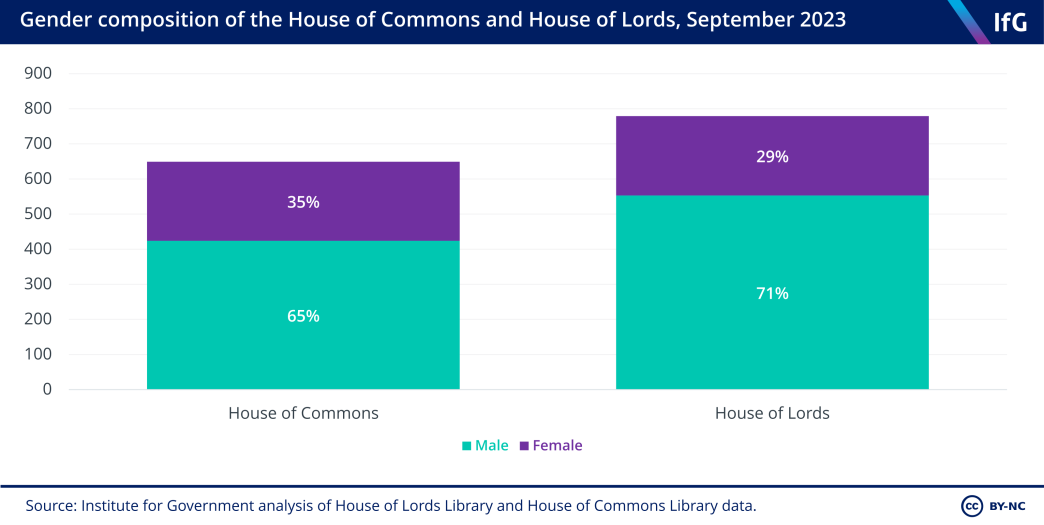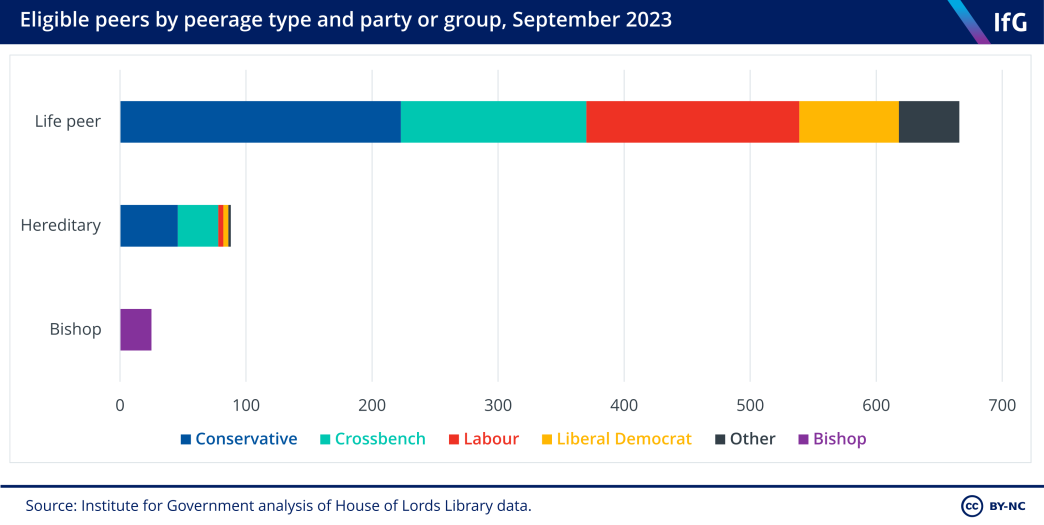House of Lords
The House of Lords is the upper chamber of the UK parliament. But what does it do?

The House of Lords is the upper chamber of the UK parliament, often referred to as the ‘revising chamber’. It has nearly 800 members that are appointed rather than elected.
What does the House of Lords do?
The House of Lords has several key legislative and scrutiny functions. The Lords shares the task of passing and scrutinising legislation with the House of Commons. It also reviews and amends proposed legislation, carrying out more detailed examination of legislation than is provided for in the Commons.
The House of Lords oversees more general scrutiny work by questioning ministers, conducting inquiries and engaging in debates. There are various Lords select committees in that investigate specialised topics and publish reports, which can contribute to more informed policy decisions.
Who is in the House of Lords?
There are 827 peers in the House of Lords as of August 2023, with 784 of peers eligible to attend proceedings (those on leave of absence or who hold certain outside roles such as sitting judges are still peers but ineligible to attend). Its size is not regulated by law, and it is the largest upper house in the world.
While there are different routes to joining the Lords, peers, unlike MPs in the Commons, are not elected by the public but are either appointed (formally by the monarch on the advice of the prime minister) or, in a small number of cases, sit in the Lords ‘by right’.
The vast majority are life peers who have been appointed for life, either as political appointees nominated by party leaders, or as crossbench peers unaffiliated to a party who are appointed for their expertise. Many have or have had successful careers in business, culture, sports, academia, law, health, public service or politics.
There are also 92 hereditary peers who continue to sit in the House of Lords ‘by right’ – that is, because of titles they have inherited. There used to be far more, but reforms in 1999 capped their number at 92. When a hereditary peer representing a political party dies or retires , a by-election among the other hereditary peers in their own party is held to choose their replacement.
There are also 26 Lords spiritual, who are senior bishops of the Church of England. They include figures like the Archbishop of Canterbury and they also sit in the Lords by right.
The average age of all eligible members of the Lords is 71, and over two thirds of this number are male (71 %). It is rare for a government to command a majority in the House of Lords. As of August 2023, the Conservatives are the largest party group with 270 eligible peers, along with 180 crossbench peers, 175 Labour peers, 84 Liberal Democrat peers, 25 bishops and 50 other peers (including peers from other parties, non-affiliated peers, and the Lord Speaker).


What powers does the House of Lords have?
The powers of the House of Lords today are limited by the Parliament Acts. The Lords has the power to delay a piece of legislation passed by the House of Commons for up to one year but cannot block a bill altogether. It is also unable to amend or initiate any ‘money bills’, which are bills that the Speaker of the Commons considers related to national taxation, public money or loans.
The power of the Lords is further restricted by the Salisbury Convention, which says that the Lords should not block government bills that implement policies proposed in an election manifesto. However, the extent of the convention is subject to ongoing discussion. During the 2017–19 parliament, there was debate surrounding whether the Lords violated the Salisbury Convention when amending the European Union (Withdrawal) Bill and Data Protection Bill.
The limits on the Lords’ power reflect the fact that it is the unelected chamber of parliament. However, the Lords still plays an important parliamentary role, particularly in shaping and refining legislation, and it is often referred to as a ‘revising chamber’. It frequently asks the House of Commons to ‘think again’ by tabling amendments to legislation that are then voted on by MPs. While it is uncommon for the government to be defeated on Lords amendments, it will often table its own amendments to address peers’ concerns.
How has the Lords changed over time?
The role and the size of the House of Lords has changed significantly over time. Until 1999, it was comprised primarily of hereditary peers and between the 1950s and 1990s, membership had increased from 850 to 1,200. The House of Lords Act 1999 reduced the number of hereditary peers entitled to sit in the House of Lords to 92 and established an independent House of Lords Appointment Commission (HOLAC) to oversee the appointment of independent expert crossbench members and to vet party political nominations. In 2000, Tony Blair said HOLAC would ensure the Lords were "more representative of our diverse society". These reforms were intended to be a first stage of reform, but the next stage was never completed.
Since November 2000, some 673 peerages have been created, with most being political appointments. The Lords has increased in size from 690 peers in November 2000, to 827 peers in 2023.
Before 2009, the House of Lords was the highest court in the land. The Constitutional Reform Act 2005, separated the judiciary from parliament, removing the Lords’ judicial remit and passing it to the Supreme Court of the UK. In 2014, reforms were passed to enable peers to retire or resign in an effort to reduce the chamber’s size.
What attempts at reform have there been?
Since 1999, there have been several unsuccessful attempts to reform the House of Lords, mostly due to disagreements over what should replace it. The 1997 Labour manifesto included a commitment to reform. When in government, the party established a royal commission chaired by Lord Wakenham recommending a mostly appointed, partly elected chamber.
In 2003, the government held a series of indicative votes in parliament on a range of options, from a fully elected to a fully appointed Lords, to gauge desire for reform in the Lords and Commons. The Lords voted in favour of a fully appointed second chamber, while the Commons voted down every proposal for reform. In a second set of indicative votes, the Commons endorsed an elected chamber, while the Lords only voted again in favour of a full appointed chamber. Further cross-party talks took place, and a further white paper was published in 2008, but progress was halted by the 2010 general election which saw a change in government.
David Cameron’s coalition government also attempted to reform the House of Lords. In 2011, another white paper was published, setting out proposals for an 80% elected and 20% appointed chamber. However, the House of Lords Reform Bill 2012 was withdrawn after backbench Conservative MPs threatened to rebel.
Since then, no further attempts at major reform have been made. The Lord Speaker’s committee on the size of the house, chaired by Lord Burns, set out proposals to reduce the size of the chamber by encouraging retirements and asking party leaders to exercise restraint in appointments. Most recently, in 2022, the Brown Commission, proposed a fully elected ‘Assembly of Nations and Regions’ and the Labour Party is expected to include Lords reform in its next manifesto.
- Legislature
- House of Lords
- Publisher
- Institute for Government